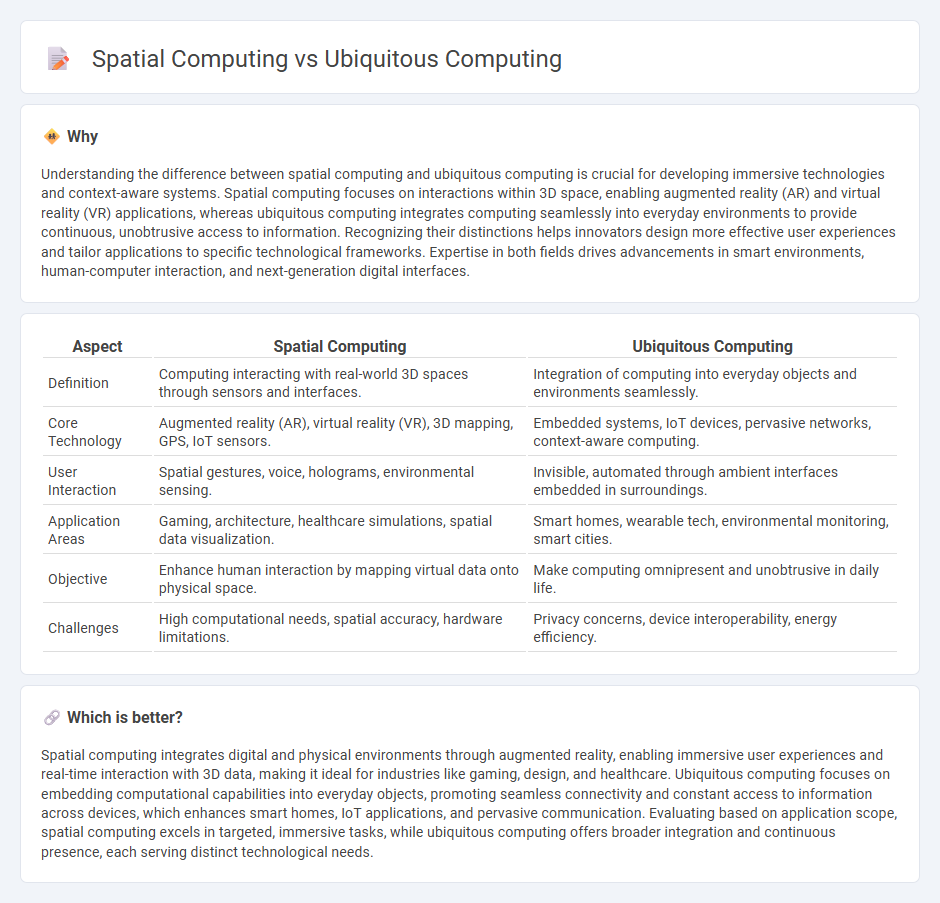
Spatial computing integrates digital content within physical spaces through technologies like augmented reality and IoT, enabling interactive environments that respond to user location and context. Ubiquitous computing embeds computational capabilities seamlessly into everyday objects and environments, facilitating constant connectivity and smart interactions without interrupting user activities. Explore how these evolving technologies transform our interaction with digital and physical worlds.
Why it is important
Understanding the difference between spatial computing and ubiquitous computing is crucial for developing immersive technologies and context-aware systems. Spatial computing focuses on interactions within 3D space, enabling augmented reality (AR) and virtual reality (VR) applications, whereas ubiquitous computing integrates computing seamlessly into everyday environments to provide continuous, unobtrusive access to information. Recognizing their distinctions helps innovators design more effective user experiences and tailor applications to specific technological frameworks. Expertise in both fields drives advancements in smart environments, human-computer interaction, and next-generation digital interfaces.
Comparison Table
| Aspect | Spatial Computing | Ubiquitous Computing |
|---|---|---|
| Definition | Computing interacting with real-world 3D spaces through sensors and interfaces. | Integration of computing into everyday objects and environments seamlessly. |
| Core Technology | Augmented reality (AR), virtual reality (VR), 3D mapping, GPS, IoT sensors. | Embedded systems, IoT devices, pervasive networks, context-aware computing. |
| User Interaction | Spatial gestures, voice, holograms, environmental sensing. | Invisible, automated through ambient interfaces embedded in surroundings. |
| Application Areas | Gaming, architecture, healthcare simulations, spatial data visualization. | Smart homes, wearable tech, environmental monitoring, smart cities. |
| Objective | Enhance human interaction by mapping virtual data onto physical space. | Make computing omnipresent and unobtrusive in daily life. |
| Challenges | High computational needs, spatial accuracy, hardware limitations. | Privacy concerns, device interoperability, energy efficiency. |
Which is better?
Spatial computing integrates digital and physical environments through augmented reality, enabling immersive user experiences and real-time interaction with 3D data, making it ideal for industries like gaming, design, and healthcare. Ubiquitous computing focuses on embedding computational capabilities into everyday objects, promoting seamless connectivity and constant access to information across devices, which enhances smart homes, IoT applications, and pervasive communication. Evaluating based on application scope, spatial computing excels in targeted, immersive tasks, while ubiquitous computing offers broader integration and continuous presence, each serving distinct technological needs.
Connection
Spatial computing and ubiquitous computing are interconnected through their integration of digital information with the physical environment, enabling seamless user interaction in real-time. Both technologies leverage sensors, edge computing, and context-aware systems to create immersive, intelligent environments where data is processed continuously to support adaptive applications. The convergence of spatial and ubiquitous computing drives advancements in augmented reality, IoT ecosystems, and smart cities by enhancing spatial awareness and pervasive connectivity.
Key Terms
Context-awareness
Ubiquitous computing integrates context-awareness by embedding sensors and devices seamlessly into everyday environments to collect real-time data for personalized user experiences. Spatial computing enhances context-awareness through 3D spatial mapping, enabling precise interaction with physical surroundings using augmented reality (AR) and virtual reality (VR) technologies. Explore how these computing paradigms revolutionize context-aware applications in smart environments and immersive experiences.
Augmented reality
Augmented reality (AR) enhances user interaction by overlaying digital content onto the physical environment, relying heavily on spatial computing technologies that understand and map real-world spaces. Ubiquitous computing emphasizes seamless integration of computing devices into everyday objects and environments, enabling continuous access to digital information without explicit user intervention. Explore the distinctions and synergies between these computing paradigms to unlock advanced AR applications and immersive experiences.
Sensor networks
Ubiquitous computing integrates sensor networks to enable seamless, omnipresent data collection and interaction across various environments, emphasizing device miniaturization and context-aware applications. Spatial computing leverages advanced sensor networks combined with 3D mapping, spatial analytics, and real-time location tracking to create immersive digital-physical experiences. Explore more about how sensor networks drive innovation in both ubiquitous and spatial computing paradigms.
Source and External Links
What is Ubiquitous Computing? - Ubiquitous computing integrates computing capabilities into everyday objects to provide seamless, intelligent, and context-aware experiences.
Ubiquitous Computing - Ubiquitous computing is a concept where computing is made to appear seamlessly anywhere and anytime, often referred to as pervasive computing.
Comprehensive Guide to Ubiquitous Computing - This guide covers the integration of computing into everyday objects, allowing them to communicate and act intelligently without human intervention.
 dowidth.com
dowidth.com